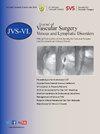Comparison of long-term outcomes and quality of life following radiofrequency ablation, endovenous laser ablation, and N-butyl cyanoacrylate treatment of greater saphenous vein insufficiency
IF 2.8
2区 医学
Q2 PERIPHERAL VASCULAR DISEASE
Journal of vascular surgery. Venous and lymphatic disorders
Pub Date : 2025-09-12
DOI:10.1016/j.jvsv.2025.102316
引用次数: 0
Abstract
Objective
To compare the long-term clinical outcomes and quality of life after radiofrequency ablation (RFA), endovenous laser ablation (EVLA), and N-butyl cyanoacrylate (NBCA) treatments in patients with chronic venous insufficiency.
Methods
This retrospective study included 600 patients treated with RFA, EVLA, or NBCA for chronic venous insufficiency at a single center between February 2015 and February 2025. Patients were divided into 3 groups of 200 according to the treatment modality. Clinical and procedural parameters, complication rates, pain scores, time to return to daily activities, Venous Clinical Severity Scores (VCSS), and great saphenous vein (GSV) occlusion rates were compared among groups.
Results
Statistically significant differences were found among the groups regarding complication rates, pain scores at 6 hours, procedure duration, time to return to daily activities, long-term GSV occlusion, and 5-year VCSS values (all P < .05). Complication-free rates were highest in the RFA group (89.5%), followed by NBCA (86.0%), and were lowest in the EVLA group (69.0%) (P < .001). EVLA had more frequent pigmentation, paresthesia, and phlebitis. NBCA had the shortest procedure time (13.7 minutes) and the greatest postprocedural pain and delayed return to daily activities. At 5 years, RFA showed the highest GSV occlusion rate (88.4%), whereas NBCA and EVLA had lower rates (70.6% and 75.0%, respectively) (P < .001). VCSS values at 5 years were more favorable in the RFA and NBCA groups compared with the EVLA group (P = .036).
Conclusions
All three endovenous techniques are effective and safe for the treatment of GSV insufficiency. However, the choice of modality should consider differences in complication rates, patient comfort, and long-term vein occlusion outcomes.
射频消融、静脉内激光消融和氰基丙烯酸丁酯治疗大隐静脉的长期预后和生活质量的比较İnsufficiency。
目的:比较慢性静脉功能不全患者射频消融术(RFA)、静脉内激光消融术(EVLA)和氰基丙烯酸正丁酯(NBCA)治疗后的长期临床结果和生活质量。方法:本回顾性研究纳入了2015年2月至2025年2月在单一中心接受RFA、EVLA或NBCA治疗慢性静脉功能不全的600例患者。根据治疗方式将患者分为三组,每组200例。比较两组患者的临床和手术参数、并发症发生率、疼痛评分、恢复日常活动时间、静脉临床严重程度评分(VCSS)和大隐静脉(GSV)闭塞率。结果:在并发症发生率、6小时疼痛评分、手术时间、恢复日常活动时间、长期GSV闭塞和5年VCSS值方面,组间差异有统计学意义(均为p)。结论:三种内静脉技术治疗大隐静脉功能不全均有效且安全。然而,模式的选择应考虑并发症发生率、患者舒适度和长期静脉阻塞结果的差异。
本文章由计算机程序翻译,如有差异,请以英文原文为准。
求助全文
约1分钟内获得全文
求助全文
来源期刊

Journal of vascular surgery. Venous and lymphatic disorders
SURGERYPERIPHERAL VASCULAR DISEASE&n-PERIPHERAL VASCULAR DISEASE
CiteScore
6.30
自引率
18.80%
发文量
328
审稿时长
71 days
期刊介绍:
Journal of Vascular Surgery: Venous and Lymphatic Disorders is one of a series of specialist journals launched by the Journal of Vascular Surgery. It aims to be the premier international Journal of medical, endovascular and surgical management of venous and lymphatic disorders. It publishes high quality clinical, research, case reports, techniques, and practice manuscripts related to all aspects of venous and lymphatic disorders, including malformations and wound care, with an emphasis on the practicing clinician. The journal seeks to provide novel and timely information to vascular surgeons, interventionalists, phlebologists, wound care specialists, and allied health professionals who treat patients presenting with vascular and lymphatic disorders. As the official publication of The Society for Vascular Surgery and the American Venous Forum, the Journal will publish, after peer review, selected papers presented at the annual meeting of these organizations and affiliated vascular societies, as well as original articles from members and non-members.
 求助内容:
求助内容: 应助结果提醒方式:
应助结果提醒方式:


